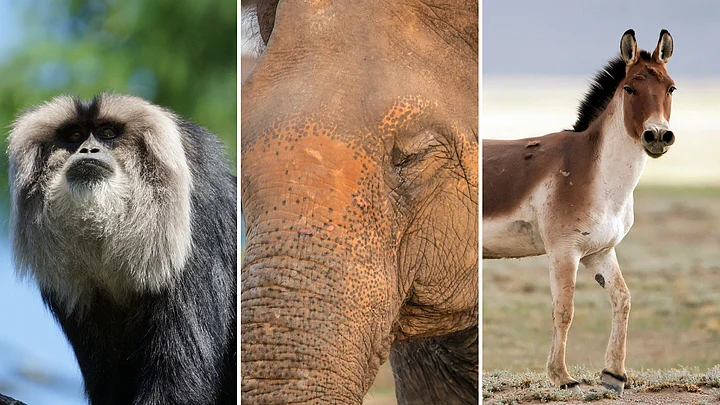The world's last male northern white rhino bid goodbye to the world on Monday. This leaves us with just two females of its subspecies alive in the world. Scientists would have to heavily rely on artificial methods of breeding such as IVF should they wish to revive this species now.
But the white rhino wasn’t alone. Several species such as the Black Rhino, Forest Elephant, Lion-tailed Macaque, Kashmiri Red Stag, Ganges Shark, and the Javan Rhino are also nearing extinction and are currently categorised as ‘critically endangered’. According to the “Red List” of The International Union for Conservation of Nature (IUCN), around 5,583 flora and fauna species are endangered. The numbers, however, are not set in stone, with new species getting added or subtracted every year.
The underlying fact, however, is that we are losing wildlife at a rapid pace. Here is a look at some of the most endangered species in India:
Red Panda
Featuring in the IUCN’s endangered species list, the Red Panda’s population is decreasing. The Red Panda is the only living species of the genus Ailurus and the family Ailuridae and losing it would mean losing something unique.
The primary reasons for the decline of the Red Panda include human interventions such as forest fragmentation and poaching, eventually leading to loss of habitat.
Primarily restricted to the Himalayan forests in India, the Red Panda can be seen in Namdapha National Park and Singalila National Park in the northeast.
Asian Elephant
According to the IUCN Red List of Threatened Species:
Listed as Endangered (EN) because of a population size reduction inferred to be at least 50% over the last three generations, based on a reduction in its area of occupancy and the quality of its habitat. Although there are few accurate data on historical population size, from what is known about trends in habitat loss/degradation and other threats including poaching, an overall population decline of at least 50% over the last three generations seems realistic.
Loss of habitat remains the topmost reason for the declining population of Asian elephants. Besides, the tusk of Asian Elephants is highly valued, which leads to the poaching of this endangered wildlife species.
A truly unique species, the Asian Elephant is said to be capable of eating around 150-200 kg of fodder and drinking about 100 litres of water in a day.
Wild Ass
Ghudkhar or the Wild Ass is found only in The Wild Ass Sanctuary of the Little Rann of Kutch in Gujarat, and is one of the fastest animals in the world. It is an endangered animal species as per the Red List of International Union For Conservation of Nature.
Increased human intervention in their natural habitat and rapid infrastructural development along with threats of poaching is leading to a decline in the population of the Wild Ass. Besides, there is also stiff competition among livestock for resources, impacting their population adversely.
Indian Bison
The Gaur or Indian Bison, residing in few protected sanctuaries in India, is an endangered herbivore species. They are known for their size and strength. An adult male bison weighs around 600 kg to 1,500 kg and an adult female weighs about 400 kg to 1,000 kg. They usually reside in the wild forests of southern and eastern India. The Nagarhole and Bandipur National Parks in Karnataka and Kaziranga and Manas National Parks in Assam are some of the places you can get a glimpse of the Indian Bison.
Human encroachment, poaching, competition from domestic cattle, food scarcity, and attacks by its natural predators like the tiger are reasons behind its declining population.
Sangai Deer
The state animal of Manipur, the Sangai Deer (or Eld’s deer) is nearing extinction. It is naturally found in the marshy grasslands of the Keibul Lamjao National Park, in the south of Loktak lake.
The primary reason for its decreasing numbers is the degeneration of its natural habitat due to human intervention, poaching, inbreeding and frequent flooding caused by artificial reservoirs.
Efforts have been made in the recent past to conserve the Sangai Deer’s natural habitat and finding alternate areas where the deer population can be rehabilitated.
(At The Quint, we question everything. Play an active role in shaping our journalism by becoming a member today.)
